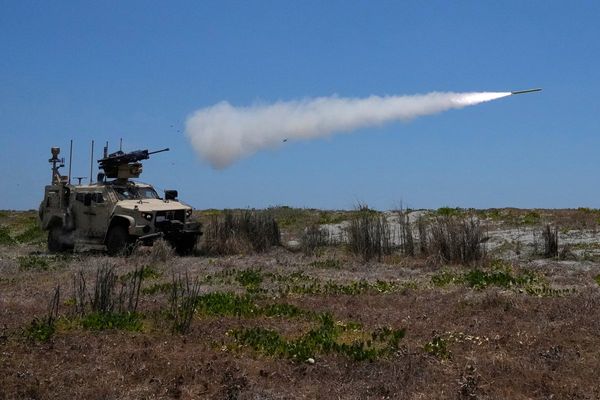
Russia said on Sunday that it plans to station tactical nuclear weapons in Belarus, a seemingly tit-for-tat response to the UK’s announcement last week that it would supply Ukraine with armour-piercing shells made from depleted uranium. Although the rounds contain trace amounts of radioactivity, Russia has falsely claimed the ammunition contains "nuclear components" to justify its move into Belarus.
A by-product of enriching uranium, depleted uranium has been stripped of most – but not all – of its radioactivity and is dense enough to pierce many types of armour.
The British government confirmed last week that it would supply Ukraine with the ammunition to aid its fight against Russia.
Russian President Vladimir Putin reacted to the news by vowing to “respond accordingly, given that the West collectively is already beginning to use weapons with a nuclear component”.
Putin followed up by quickly inking a deal with long-time ally Alexander Lukashenko to store nuclear arms in Belarus.
The British government replied to Putin’s threat by accusing him of spreading disinformation, noting that British forces have been using the armour-piercing shells legally “for several decades” in accordance with Article 36 of the 1977 Protocol Additional to the Geneva Conventions.
Washington voiced its support for the UK’s initiative last Thursday, with John Kirby, the National Security Council's strategic communications coordinator, stating that the ammunition “is not radioactive” and "not anywhere close to" the realm of nuclear weaponry.
From Nazi Germany to the wars in Yugoslavia
Several studies have shown that depleted uranium is less radioactive than its enriched cousin because it contains fewer isotopes.
Nevertheless, delivering these kind of shells to Kyiv will provide an argument for those who buy into the "Russian rhetoric on how the West is responsible for aggravating the conflict”, said Jeff Hawn, a Ukraine war specialist and a non-resident fellow at the New Lines Institute, a Washington, DC-based think tank.
"This is standard anti-tank ammunition that can be used against anything armoured,” Hawn said.
These kind of shells have gotten bad press for decades, but the dangers of exposure to their radiation have never been clearly proven or disproven due to contradicting scientific studies.
The idea of using depleted uranium in ammunition dates back to Nazi Germany. In 1943, the Reich's minister of armaments and war production, Albert Speer, hoped to use the radioactive material to replace tungsten, an essential component of tank shells that was in short supply. There is no evidence the Third Reich managed to create depleted-uranium shells, but the United States advanced the technology to developed “tank killer” munitions in the 1970s.
“The US wanted to have the most efficient weapons in case of armed conflicts in Europe against Soviet tanks,” Hawn said.
Depleted-uranium shells proved to be ideal against tanks, as “they are much denser than the other, more widely available heavy-tank ammunition”, Hawn said, citing another advantage in its combustibility. “They are extremely flammable and self-sharpening rather than flattening, like tungsten ammunition," he explained, adding that these munitions often lead a tank to explode because of the heat produced near its fuel tank.
One of the major downsides remains the fact that, even when depleted, uranium is quite toxic. Although countries including France, the UK, the US, China and Pakistan have produced such shells, they remain in limited use.
"For most countries, this is 'politically toxic' ammunition. The cost-benefit equation compared to tungsten rounds is not in favour of uranium shells," Hawn said.
Uncertainty over health risks
Only the US and UK have openly used the armour-piercing shells, notably during the first Gulf War (1990-1991) and the wars in the decade following the breakup of Yugoslavia (1991-2001). Many studies have since been published in an effort to evaluate their potential damage to health.
Research on the subject initially focused on the health risks incurred by soldiers in handling the depleted-uranium shells. The focus later shifted to the long-term health risks incurred by local inhabitants due to radiation. For example, studies have been conducted in Iraq to link – unsuccessfully – an increase in cancer cases in certain regions to the use of depleted-uranium shells by the US army.
The risks are two-fold: first, debris from the shells remains radioactive and potentially dangerous in case of prolonged exposure. Second, the shells emit a cloud of radioactive dust upon impact that goes on to pollute the environment. Soil and water tables can thus be tainted, which can then contaminate local populations through ingestion, a report published by the Royal Society showed.
Meanwhile, the US and UK have insisted for years that the health risks are minimal. The British Royal Society concluded that the risk of lung cancer is somewhat higher, but only in cases of direct exposure to the shells for long periods of time.
Despite the large body of scientific work on the subject, the UN has deemed it necessary to continue evaluating the health risks tied to the use of depleted-uranium shells while noting that no significant proof of health risks has yet been established.
Nevertheless, the use of such shells has "a lasting environmental effect", Hawn said.
Despite the environmental risks, Hawn defends the UK’s decision to supply Ukraine with the munitions, saying that "there are a lot of depleted-uranium rounds sitting around in stockpiles". Given a shortage of ammunition, "it’s a good way to get [Ukraine] ammunition quickly".
"At the end of the day, Ukraine should use whatever they can to defend themselves, and one advantage with this ammunition is that they can increase the firing range, which helps Ukrainian soldiers – who are outnumbered by Russians – stay safe," he added.
And this might be the real reason behind Russia’s concern – not the radioactivity of the anti-tank munitions, but that the armour-busting bullets might help its adversary gain the upper hand.
This article has been translated from the original in French.







